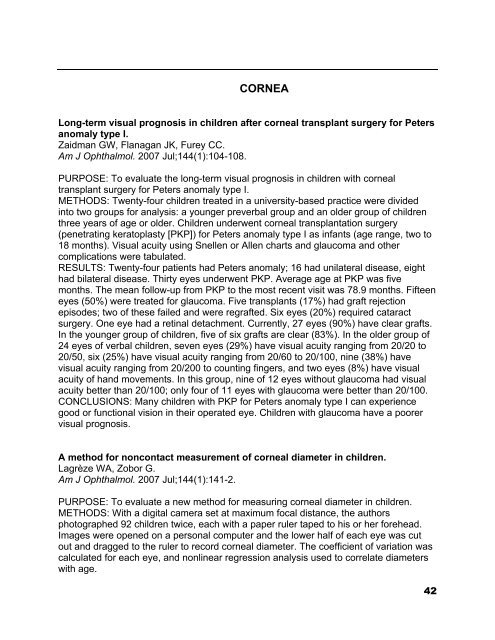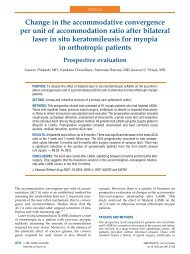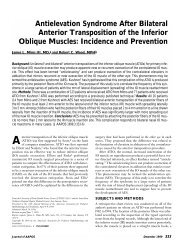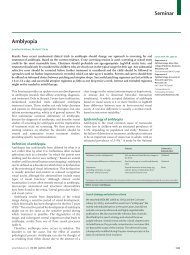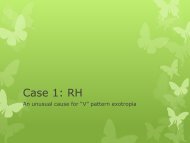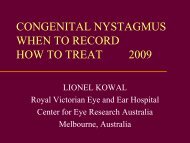What's new AAPOS 2008 - The Private Eye Clinic
What's new AAPOS 2008 - The Private Eye Clinic
What's new AAPOS 2008 - The Private Eye Clinic
Create successful ePaper yourself
Turn your PDF publications into a flip-book with our unique Google optimized e-Paper software.
CORNEA<br />
Long-term visual prognosis in children after corneal transplant surgery for Peters<br />
anomaly type I.<br />
Zaidman GW, Flanagan JK, Furey CC.<br />
Am J Ophthalmol. 2007 Jul;144(1):104-108.<br />
PURPOSE: To evaluate the long-term visual prognosis in children with corneal<br />
transplant surgery for Peters anomaly type I.<br />
METHODS: Twenty-four children treated in a university-based practice were divided<br />
into two groups for analysis: a younger preverbal group and an older group of children<br />
three years of age or older. Children underwent corneal transplantation surgery<br />
(penetrating keratoplasty [PKP]) for Peters anomaly type I as infants (age range, two to<br />
18 months). Visual acuity using Snellen or Allen charts and glaucoma and other<br />
complications were tabulated.<br />
RESULTS: Twenty-four patients had Peters anomaly; 16 had unilateral disease, eight<br />
had bilateral disease. Thirty eyes underwent PKP. Average age at PKP was five<br />
months. <strong>The</strong> mean follow-up from PKP to the most recent visit was 78.9 months. Fifteen<br />
eyes (50%) were treated for glaucoma. Five transplants (17%) had graft rejection<br />
episodes; two of these failed and were regrafted. Six eyes (20%) required cataract<br />
surgery. One eye had a retinal detachment. Currently, 27 eyes (90%) have clear grafts.<br />
In the younger group of children, five of six grafts are clear (83%). In the older group of<br />
24 eyes of verbal children, seven eyes (29%) have visual acuity ranging from 20/20 to<br />
20/50, six (25%) have visual acuity ranging from 20/60 to 20/100, nine (38%) have<br />
visual acuity ranging from 20/200 to counting fingers, and two eyes (8%) have visual<br />
acuity of hand movements. In this group, nine of 12 eyes without glaucoma had visual<br />
acuity better than 20/100; only four of 11 eyes with glaucoma were better than 20/100.<br />
CONCLUSIONS: Many children with PKP for Peters anomaly type I can experience<br />
good or functional vision in their operated eye. Children with glaucoma have a poorer<br />
visual prognosis.<br />
A method for noncontact measurement of corneal diameter in children.<br />
Lagrèze WA, Zobor G.<br />
Am J Ophthalmol. 2007 Jul;144(1):141-2.<br />
PURPOSE: To evaluate a <strong>new</strong> method for measuring corneal diameter in children.<br />
METHODS: With a digital camera set at maximum focal distance, the authors<br />
photographed 92 children twice, each with a paper ruler taped to his or her forehead.<br />
Images were opened on a personal computer and the lower half of each eye was cut<br />
out and dragged to the ruler to record corneal diameter. <strong>The</strong> coefficient of variation was<br />
calculated for each eye, and nonlinear regression analysis used to correlate diameters<br />
with age.<br />
42


